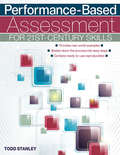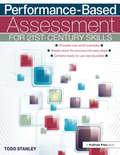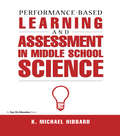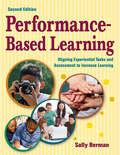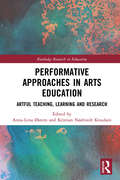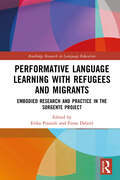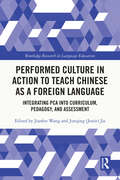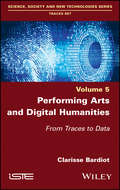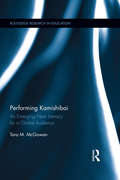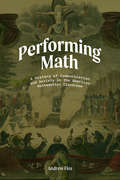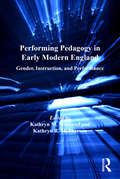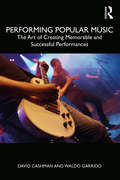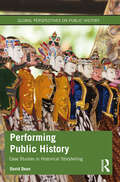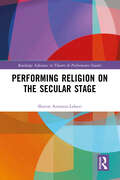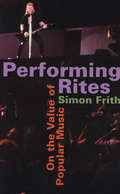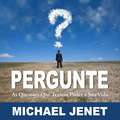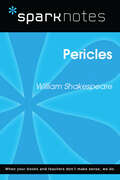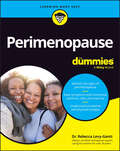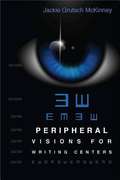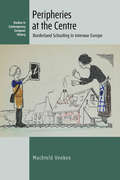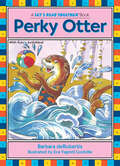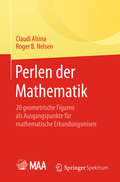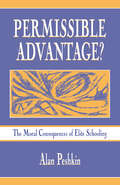- Table View
- List View
Performance-Based Assessment for 21st-Century Skills
by Todd StanleyPerformance-based assessments allow classroom teachers an alternative to traditional multiple-choice tests. We often use fill-in-the bubble assessments in education to determine the readiness of students. However, in the 21st-century workplace, these types of tests fail to truly prepare students. How many times in the real world are we called upon to take a multiple-choice test? In the real world, we are called upon to prove our merit through performance-based assessments, displaying our 21st-century skills. We should be preparing students for this in the classroom. Performance-Based Assessment for 21st-Century Skills makes the argument that teachers should use performance-based assessments in the classroom. It guides the educator step by step to show how he or she can create performance-based assessments for students, including what they look like, teaching students how to create them, setting the proper classroom environment, and how to evaluate them.
Performance-Based Assessment for 21st-Century Skills
by Todd StanleyPerformance-based assessments allow classroom teachers an alternative to traditional multiple-choice tests. We often use fill-in-the bubble assessments in education to determine the readiness of students. However, in the 21st-century workplace, these types of tests fail to truly prepare students. How many times in the real world are we called upon to take a multiple-choice test? In the real world, we are called upon to prove our merit through performance-based assessments, displaying our 21st-century skills. We should be preparing students for this in the classroom. Performance-Based Assessment for 21st-Century Skills makes the argument that teachers should use performance-based assessments in the classroom. It guides the educator step by step to show how he or she can create performance-based assessments for students, including what they look like, teaching students how to create them, setting the proper classroom environment, and how to evaluate them.
Performance-Based Learning & Assessment in Middle School Science
by K. Michael HibbardThis book contains a collection of performance tasks and easy-to-use assessment tools, ready to be photocopied and distributed to your students. The tasks in this book ask students to write letters, prepare posters, create charts and graphs, prepare 3D models, write skits, take surveys, and otherwise apply what they have learned.
Performance-Based Learning: Aligning Experiential Tasks and Assessment to Increase Learning
by Sally BermanOffers sample lesson plans that promote performance-based learning throughout the content areas, plus rubrics, updated research, projects, and an expanded discussion of cooperative learning teams.
Performative Approaches in Arts Education: Artful Teaching, Learning and Research (Routledge Research in Education)
by Anna-Lena Østern Kristian Nødtvedt KnudsenIn Performative Approaches in Arts Education, researchers, artists and practitioners from philosophy and the arts elaborate on what performative approaches can contribute to 21st century arts education. Introducing new perspectives on learning, the contributors provide a central international perspective, developing a paradigm in which the artist, teacher and researcher’s form of teaching is enmeshed with content, and human agency is entangled with non-human matter. The book explores issues connected to both teaching and learning in the arts, engaging in debates about the value of meaning making in the artistic process, the way social ethos can guide performative approaches and the changes in education that performative approaches can bring. Performative Approaches in Arts Education will be of great interest to academics, researchers and post-graduate students in the fields of arts education, philosophy of education and education research methods. It will also appeal to teachers and teacher educators, artists and teaching artists.
Performative Language Learning with Refugees and Migrants: Embodied Research and Practice in the Sorgente Project (Routledge Research in Language Education)
by Erika Piazzoli Fiona DalzielThis book investigates the use of performative language pedagogy in working with refugees and migrants, exploring performative language teaching as the application of drama, music, dance and storytelling to second language acquisition.Documenting a community-based project – funded by the Irish Research Council and conducted with three groups of refugees and migrants in Ireland and Italy – the book explores the methodological, pedagogical and ethical elements of performative language learning in the context of migration. Written by a team of arts-based researchers and practitioners, chapters discuss findings from the project that relate to factors such as embodied research methods, a motivation to belong and the ethical imagination, while exhibiting how performative language pedagogy can be effective in supporting children and adults in a range of challenging contexts.Offering a poetic and pictorial representation of the Sorgente Project, this book will be of interest to postgraduate students, researchers and academics in the fields of English language arts and literacy education, drama in education, the sociology of education and second language acquisition more broadly. Those working in refugee and migrant studies, and teacher education studies will also find the volume of use.
Performed Culture in Action to Teach Chinese as a Foreign Language: Integrating PCA into Curriculum, Pedagogy, and Assessment (Routledge Research in Language Education)
by Jianfen Wang Junqing Jessie JiaThis volume explores best practice in implementing the Performed Culture Approach (PCA) in teaching Chinese as a foreign language (CFL). Offering a range of chapters which demonstrate how PCA has been successfully applied to curriculum, instructional design, and assessment in CFL programs and classrooms at various levels, this text shows how PCA’s culture-focused paradigm differs fundamentally from the general communicative language teaching (CLT) framework and highlights how it can inspire innovative methods to better support learners’ ability to navigate target culture and overcome communication barriers. Additional applications of PCA in the development of learner identity, intercultural competence, autonomy, and motivation are also considered. Bridging theoretical innovations and the practice of curriculum design and implementation, this work will be of value to researchers, teacher trainers, and graduate students interested in Chinese teaching and learning, and especially those with interest in incorporating performance into foreign language curriculums with the goal of integrating language and culture.
Performed Culture in Action to Teach Chinese as a Foreign Language: Integrating PCA into Curriculum, Pedagogy, and Assessment (Routledge Research in Language Education)
by Jianfen Wang Junqing Jessie JiaThis volume explores best practices in implementing the Performed Culture Approach (PCA) in teaching Chinese as a foreign language (CFL).Offering a range of chapters that demonstrate how PCA has been successfully applied to curriculum, instructional design, and assessment in CFL programs and classrooms at various levels, this text shows how PCA’s culture-focused paradigm differs fundamentally from the general communicative language teaching (CLT) framework and highlights how it can inspire innovative methods to better support learners’ ability to navigate target culture and overcome communication barriers. Additional applications of PCA in the development of learner identity, intercultural competence, autonomy, and motivation are also considered.Bridging theoretical innovations and the practice of curriculum design and implementation, this work will be of value to researchers, teacher trainers, and graduate students interested in Chinese teaching and learning, especially those with an interest in incorporating performance into foreign language curriculums with the goal of integrating language and culture.
Performing Arts and Digital Humanities: From Traces to Data
by Clarisse BardiotDigital traces, whether digitized (programs, notebooks, drawings, etc.) or born digital (emails, websites, video recordings, etc.), constitute a major challenge for the memory of the ephemeral performing arts.Digital technology transforms traces into data and, in doing so, opens them up to manipulation. This paradigm shift calls for a renewal of methodologies for writing the history of theater today, analyzing works and their creative process, and preserving performances. At the crossroads of performing arts studies, the history, digital humanities, conservation and archiving, these methodologies allow us to take into account what is generally dismissed, namely, digital traces that are considered too complex, too numerous, too fragile, of dubious authenticity, etc.With the analysis of Merce Cunningham’s digital traces as a guideline, and through many other examples, this book is intended for researchers and archivists, as well as artists and cultural institutions.
Performing Kamishibai: An Emerging New Literacy for a Global Audience (Routledge Research in Education)
by Tara McGowanKamishibai (paper-theater), a Japanese picture-storytelling medium, is gaining global interest as we move from a text-based culture to one that emphasizes multiple semiotic systems and performance. This is the first volume to explore the potential of kamishibai as a dynamic "new" interactive medium for teaching multimodal communication and shows how synchronizing oral, visual and gestural modes develops students’ awareness of all modes of communication as potential resources in their learning. By examining the multiple modes involved in kamishibai through actual student performances over several venues, this volume overturns commonly held expectations about literacy in the classroom and provides a critical perspective on assumptions about other media. It offers much-needed information about a medium that is attracting interest from educators, academics and artists worldwide.
Performing Math: A History of Communication and Anxiety in the American Mathematics Classroom
by Andrew FissPerforming Math tells the history of expectations for math communication—and the conversations about math hatred and math anxiety that occurred in response. Focusing on nineteenth-century American colleges, this book analyzes foundational tools and techniques of math communication: the textbooks that supported reading aloud, the burnings that mimicked pedagogical speech, the blackboards that accompanied oral presentations, the plays that proclaimed performers’ identities as math students, and the written tests that redefined “student performance.” Math communication and math anxiety went hand in hand as new rules for oral communication at the blackboard inspired student revolt and as frameworks for testing student performance inspired performance anxiety. With unusual primary sources from over a dozen educational archives, Performing Math argues for a new, performance-oriented history of American math education, one that can explain contemporary math attitudes and provide a way forward to reframing the problem of math anxiety.
Performing Pedagogy in Early Modern England: Gender, Instruction, and Performance (Studies In Performance And Early Modern Drama Ser.)
by Kathryn M. MoncriefPerforming Pedagogy in Early Modern England: Gender, Instruction, and Performance features essays questioning the extent to which education, an activity pursued in the home, classroom, and the church, led to, mirrored, and was perhaps even transformed by moments of instruction on stage. This volume argues that along with the popular press, the early modern stage is also a key pedagogical site and that education”performed and performative”plays a central role in gender construction. The wealth of sixteenth- and seventeenth-century printed and manuscript documents devoted to education (parenting guides, conduct books, domestic manuals, catechisms, diaries, and autobiographical writings) encourages examination of how education contributed to the formation of gendered and hierarchical structures, as well as the production, reproduction, and performance of masculinity and femininity. In examining both dramatic and non-dramatic texts via aspects of performance theory, this collection explores the ways education instilled formal academic knowledge, but also elucidates how educational practices disciplined students as members of their social realm, citizens of a nation, and representatives of their gender.
Performing Popular Music: The Art of Creating Memorable and Successful Performances
by David Cashman Waldo GarridoThis book explores the fundamentals of popular music performance for students in contemporary music institutions. Drawing on the insights of performance practice research, it discusses the unwritten rules of performances in popular music, what it takes to create a memorable performance, and live popular music as a creative industry. The authors offer a practical overview of topics ranging from rehearsals to stagecraft, and what to do when things go wrong. Chapters on promotion, recordings, and the music industry place performance in the context of building a career. Performing Popular Music introduces aspiring musicians to the elements of crafting compelling performances and succeeding in the world of today’s popular music.
Performing Public History: Case Studies in Historical Storytelling (Global Perspectives on Public History)
by David DeanPerforming Public History explores history-telling as a performance across a wide range of media, including theatre and film, historical re-enactments and living history performances, operas, and video games.Taking historians as storytellers, this book illustrates how the choices they make shape historical meaning. While historians may strive to be objective when they research and write the past, they inevitably draw on their imagination, emotions, and creativity, aligning them with others who make history in public. The book explores issues such as the nature of archives, realism, fact and fiction, accuracy and authenticity, and actants and audiences. It draws on case studies from all parts of the world, offering global perspectives that invite a rethinking about what history is, and how and why we do it. Sharing work by graduate students, the author also offers an appendix of classroom exercises that instructors will find valuable.Written accessibly for students, this volume offers a succinct account of the discipline of history, the field of public history, and how performance is a useful concept for thinking about history work.
Performing Religion on the Secular Stage (Routledge Advances in Theatre & Performance Studies)
by Sharon Aronson-LehaviThis book examines the relations between Western religion, secularism, and modern theater and performance. Sharon Aronson-Lehavi posits that the ongoing cultural power of religious texts, icons, and ideas on the one hand and the artistic freedom enabled by secularism and avant-garde experimentalism on the other, has led theatre artists throughout the twentieth century to create a uniquely modern theatrical hybrid–theater performances that simultaneously re-inscribe and grapple with religion and religious performativity. The book compares this phenomenon with medieval forms of religious theater and offers deep and original analyses of significant contemporary works ranging from plays and performances by August Strindberg, Hugo Ball (Dada), Jerzy Grotowski, and Hanoch Levin, to those created by Adrienne Kennedy, Rina Yerushalmi, Deb Margolin, Milo Rau, and Sarah Ruhl. The book analyzes a new and original historiography of a uniquely modern theatrical phenomenon, a study that is of high importance considering the reemergence of religion in contemporary culture and politics.
Performing Rites: On the Value of Popular Music
by Simon FrithAn influential writer on popular music asks what we talk about when we talk about music. Instead of dismissing emotional response and personal taste as inaccessible to academic critics, Frith takes these forms of engagement as his subject—and discloses their place at the center of the aesthetics that structure our culture and color our lives.
Pergunte: As Questões Que Trazem Poder À Sua Vida
by Mafalda Pinto Michael JenetPORQUÊ? Porque é que algumas pessoas vivem mais felizes, são mais bem-sucedidas e têm vidas mais preenchidas, enquanto outras se sentem infelizes, em esforço constante e vazias? "PERGUNTE" dá-lhe a resposta. Como diz Jenet, "A vida é suposto ser vivida, não suportada". Num estilo coloquial, de fácil leitura e bem-humorado, salpicado com explicações lógicas, passos simples e exemplos da vida real, Michael Jenet mostra como obter mais da vida, independentemente de onde se encontra neste momento. A resposta à pergunta do "porquê" está nas questões que residem na nossa mente. Aprender a controlar essas questões, para elevar as nossas QI (Questões Intencionais) é o segredo por trás daqueles que vivem mais felizes e com vidas mais preenchidas, ao contrário dos que apenas sobrevivem. Este livro inclui uma caixa de ferramentas para o orientar e ajudar a melhorar de imediato: a sua carreira, o seu relacionamento, a sua saúde, a sua espiritualidade, o seu valor, a sua felicidade, a sua vida. Não importa em que fase da vida esteja, se quiser obter mais de cada dia, viver com mais alegria, mais sucesso, mais felicidade e, de facto, viver a vida e não apenas suportá-la, este livro irá ensiná-lo como o fazer.
Pericles (SparkNotes Literature Guide Series)
by SparkNotesPericles (SparkNotes Literature Guide) by William Shakespeare Making the reading experience fun! Created by Harvard students for students everywhere, SparkNotes is a new breed of study guide: smarter, better, faster. Geared to what today's students need to know, SparkNotes provides: *Chapter-by-chapter analysis *Explanations of key themes, motifs, and symbols *A review quiz and essay topicsLively and accessible, these guides are perfect for late-night studying and writing papers
Perimenopause For Dummies
by Rebecca Levy-GanttGet to know perimenopause and manage troublesome symptoms Perimenopause For Dummies is a practical and comprehensive guide to the emotional, mental, and physical changes that begin to happen as you approach menopause. Demystify the connection between hormones and aging and make informed choices about how to deal with symptoms like weight gain, hot flashes, depression, mood swings, and insomnia. You’ll learn about natural remedies and medical interventions that can ease the transition between fertility and menopause. Most importantly, you’ll know what to expect, so the changes happening in your body won’t take you by surprise. This Dummies guide is like a trusted friend who can guide you through your life’s next chapter. Learn what perimenopause is and identify the most common symptoms Understand how perimenopause can affect your body, emotions, and libido Ease symptoms with hormonal solutions, diet, and exercise Discover ways of supporting yourself or your loved ones through perimenopausePerimenopause For Dummies offers clear, compassionate answers for anyone who is currently experiencing perimenopause or who is ready to learn more about it.
Peripheral Visions for Writing Centers
by Jackie Grutsch MckinneyPeripheral Visions for Writing Centers aims to inspire a re-conception and re-envisioning of the boundaries of writing center work. Moving beyond the grand narrative of the writing center--that it is a solely comfortable, yet iconoclastic place where all students go to get one-on-one tutoring on their writing--Grutsch McKinney shines light on other representations of writing center work.Grutsch McKinney argues that this grand narrative neglects the extent to which writing center work is theoretically and pedagogically complex, with ever-changing work and conditions, and results in a straitjacket for writing center scholars, practitioners, students, and outsiders alike. Peripheral Visions for Writing Centers makes the case for a broader narrative of writing center work that recognizes and theorizes the various spaces of writing center labor, allows for professionalization of administrators, and sees tutoring as just one way to perform writing center work. Grutsch McKinney explores possibilities that lie outside the grand narrative, allowing scholars and practitioners to open the field to a fuller, richer, and more realistic representation of their material labor and intellectual work.
Peripheries at the Centre: Borderland Schooling in Interwar Europe (Contemporary European History #27)
by Machteld VenkenFollowing the Treaty of Versailles, European nation-states were faced with the challenge of instilling national loyalty in their new borderlands, in which fellow citizens often differed dramatically from one another along religious, linguistic, cultural, or ethnic lines. Peripheries at the Centre compares the experiences of schooling in Upper Silesia in Poland and Eupen, Sankt Vith, and Malmedy in Belgium — border regions detached from the German Empire after the First World War. It demonstrates how newly configured countries envisioned borderland schools and language learning as tools for realizing the imagined peaceful Europe that underscored the political geography of the interwar period.
Perky Otter: Vowel Combination Er (Let's Read Together ®)
by Barbara deRubertisLet&’s Read Together books merge rhyme and vowel sounds in delightfully zany stories kids will want to read again and again. Each of the 15 books in this classic series by award-winning author/educator Barbara deRubertis will give your child a jumpstart on reading success."Story lines are silly and inventive, and recall Dr. Seuss&’s Cat in the Hat for the building of rhythm and rhyming words." —School Library JournalPerky Otter and busy Bert the Beaver learn that they have a few things in common after all. (This easy-to-read story features the "er" vowel combination.)
Perlen der Mathematik: 20 geometrische Figuren als Ausgangspunkte für mathematische Erkundungsreisen
by Claudi Alsina Roger B. NelsenDieses Buch handelt von 20 geometrischen Figuren (Icons), die eine wichtige Rolle bei der Veranschaulichung mathematischer Beweise spielen. Alsina und Nelsen untersuchen die Mathematik, die hinter diesen Figuren steckt und die sich aus ihnen ableiten lässt.Jedem in diesem Buch behandelten Icons ist ein eigenes Kapitel gewidmet, in dem sein Alltagsbezug, seine wesentlichen mathematischen Eigenschaften sowie seine Bedeutung für visuelle Beweise vieler mathematischer Sätze betont werden. Diese Sätze umfassen unter anderem auch klassische Ergebnisse aus der ebenen Geometrie, Eigenschaften der natürlichen Zahlen, Mittelwerte und Ungleichungen, Beziehungen zwischen Winkelfunktionen, Sätze aus der Differenzial- und Integralrechnung sowie Rätsel aus dem Bereich der Unterhaltungsmathematik. Darüber hinaus enthält jedes Kapitel eine Auswahl an Aufgaben, anhand derer die Leser weitere Eigenschaften und Anwendungen der Diagramme erkunden können.Das Buch ist für alle geschrieben, die Freude an der Mathematik haben; Lehrkräfte und Dozenten der Mathematik werden in diesem Buch sehr nützliche Beispiele für Problemlösungen sowie umfangreiches Unterrichts- und Seminarmaterial zu Beweisen und mathematischer Argumentation finden.
Permanent Crisis: The Humanities in a Disenchanted Age (Studies in the History of the University)
by Paul Reitter Chad WellmonLeads scholars and anyone who cares about the humanities into more effectively analyzing the fate of the humanities and digging into the very idea of the humanities as a way to find meaning and coherence in the world. The humanities, considered by many as irrelevant for modern careers and hopelessly devoid of funding, seem to be in a perpetual state of crisis, at the mercy of modernizing and technological forces that are driving universities towards academic pursuits that pull in grant money and direct students to lucrative careers. But as Paul Reitter and Chad Wellmon show, this crisis isn’t new—in fact, it’s as old as the humanities themselves. Today’s humanities scholars experience and react to basic pressures in ways that are strikingly similar to their nineteenth-century German counterparts. The humanities came into their own as scholars framed their work as a unique resource for resolving crises of meaning and value that threatened other cultural or social goods. The self-understanding of the modern humanities didn’t merely take shape in response to a perceived crisis; it also made crisis a core part of its project. Through this critical, historical perspective, Permanent Crisis can take scholars and anyone who cares about the humanities beyond the usual scolding, exhorting, and hand-wringing into clearer, more effective thinking about the fate of the humanities. Building on ideas from Max Weber and Friedrich Nietzsche to Helen Small and Danielle Allen, Reitter and Wellmon dig into the very idea of the humanities as a way to find meaning and coherence in the world. ,
Permissible Advantage?: The Moral Consequences of Elite Schooling (Sociocultural, Political, and Historical Studies in Education)
by Alan PeshkinThis study of Edgewood Academy--a private, elite college preparatory high school--examines what moral choices look like when they are made by the participants in an exceptionally wealthy school, and what the very existence of a privileged school indicates about American society. It extends Peshkin's ongoing exploration of U.S. high schools and their communities, each focused in a different sociocultural setting. In this particular inquiry, he began with two central questions: * What is a school like whose students enter with a determined disposition to attend college, and all of whom are selected on the promise they display for college success? * What can be learned from studying Edgewood Academy that transcends the particular case of this school? The volume opens with a description of how moral choices look when they are made by the participants in an exceedingly wealthy school. There is a general picture of the Academy, a discussion of the processes the school uses to insure the quality of its students and educators, and an overview of teachers and students that reveals what is commendable about each group. These chapters clarify what a school of ample financial means and wise leadership can do. Peshkin goes on to reflect briefly on privilege and concludes with a discussion of what the very existence of a privileged school indicates about American society. Schools, he suggests, are about much more than what goes on inside them--they mirror what is and is not at stake for their particular constituents--and function similarly for the nation. Edgewood Academy's host community is not a village, town, church, or tribe, as in Peshkin's previous studies. It is a community created by shared aspirations for high-level academic attainment and its associated benefits. Affluence and towering academic achievement are the two most relevant factors. In this book, advantage occupies center stage. The school's excellence is documented not to extol its success, but, rather, to call attention to what is available for its students that is not available for most American children. The focus, ultimately, is on educational justice as illuminated by the advantage of Academy students--that is, on justice denied, not because anyone or any group or agency consciously, planfully sets out to do injustice to other children, but because injustice happens as the artifact of imagined limitations of resources and means. Peshkin's purpose is not to detail the particulars of how educational justice is denied to the many, but to portray and examine the meaning of a privileged school where educational justice prevails for the few.
